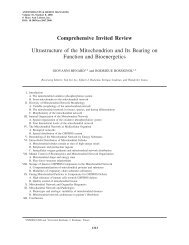MiPsummer Programme pdf - Mitochondrial Physiology Society
MiPsummer Programme pdf - Mitochondrial Physiology Society
MiPsummer Programme pdf - Mitochondrial Physiology Society
You also want an ePaper? Increase the reach of your titles
YUMPU automatically turns print PDFs into web optimized ePapers that Google loves.
72<br />
Abstract # 41<br />
Superoxide dismutase 2 and thioredoxin reductase 2 in the adult rat ovary during follicular<br />
development<br />
Li Meng, Katja Teerds., Jaap Keijer<br />
Human and Animal <strong>Physiology</strong>, Animal Sciences, Wageningen University, Wageningen, The<br />
Netherlands. li.meng@wur.nl<br />
Background Reactive oxygen species (ROS) and their scavenging systems play important<br />
physiological roles in the ovary[1]. How these processes are exactly regulated during follicular<br />
development and atresia is still unclear. Superoxide dismutase 2 (SOD2), located in the<br />
mitochondria, metabolizes superoxide radicals to hydrogen peroxide, which is further detoxified to<br />
water and oxygen by catalase or glutathione peroxidase. Although SOD2 has been localized in the<br />
human and bovine ovary, its localization in the rat and mouse ovary during follicular development<br />
and atresia is less clear. Thioredoxin reductase 2 (TXNRD2), a reductase of thioredoxin2 (TXN2),<br />
provides a major line of defence against mitochondrial ROS, nevertheless, not much is known about<br />
the localization of TXNRD2 in the mammalian ovary[2].<br />
Objectives To identify the localization of SOD2 and TXNRD2 in ovaries of adult rats in order to<br />
understand their role in normal follicle development and atresia.<br />
Methods SOD2 and TXNRD2 protein levels were measured in ovaries from 100-day-old adult rats,<br />
using western-blotting on homogenates of whole ovaries. The cellular localization of SOD2 and<br />
TXNRD2 was determined by immunohistochemistry using 5 µm thick paraffin sections. The<br />
sections were stained using a rabbit polyclonal antibody against SOD2 (diluted 1:1000, Abcam) and<br />
TXNRD2 (diluted 1:200, Novus). Staining was performed in ovaries of at least 6 animals. For<br />
western blotting the same antibodies were used at dilutions of 1:5000 and 1:500 for SOD2 and<br />
TXNRD2, respectively.<br />
Results In the western blots, specific bands for SOD2 and TXNRD2 were detected at the expected<br />
molecular weight of 25 kD and 56 kD, respectively.<br />
Immunohistochemical analysis showed the prominent presence of SOD2 in healthy preantral and<br />
preovulatory follicles (staining in theca and granulosa cells, and oocyte) and in the luteal cells of the<br />
corpora lutea (CL). Staining was faint to absent in granulosa cells of atretic preantral and antral<br />
follicles. TXNRD2 immunostaining was observed in the granulosa and theca cells of healthy<br />
preantral and antral, and conspicuously present in the steroidogenic cells of the CL. TXNRD2<br />
staining was faint to absent in granulosa and theca cells of atretic preantral and antral follicles.<br />
Conclusion SOD2 and TXNRD2 are present in granulosa and theca cells of developing healthy<br />
follicles in the adult rat ovary, but staining is faint to absent in atretic follicles. It is possible that the<br />
levels of these proteins in granulosa cells of atretic follicles are not high enough to scavenge<br />
superoxide radicals, resulting in increased superoxide radical levels which may cause cell death<br />
leading to follicular atresia.<br />
1. Devine PJ, Perreault SD, Luderer U. Roles of reactive oxygen species and antioxidants in ovarian toxicity. Biol<br />
Reprod 2012; 86:27<br />
2. Jones ML, Mark PJ, Lewis JL, Mori TA, Keelan JA, Waddell BJ. Antioxidant defenses in the rat placenta in late<br />
gestation: increased labyrinthine expression of superoxide dismutases, glutathione peroxidase 3, and uncoupling<br />
protein 2. Biol Reprod 2010; 83:254-260



